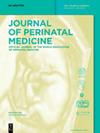作为双胎妊娠早产筛查工具的宫颈长度:对优质临床实践指南的系统回顾和批判性评估
IF 1.7
4区 医学
Q3 OBSTETRICS & GYNECOLOGY
引用次数: 0
摘要
与单胎相比,双胎妊娠发生早产(PTB)的风险更高。评估宫颈长度(CL)是筛查单胎早产的最佳工具。相反,在双胞胎中使用宫颈长度的证据却较少。我们的目的是采用 AGREE II 方法评估临床实践指南(CPG)中有关在双胞胎中应用宫颈长度的方法质量和临床异质性。方法 对 MEDLINE、Scopus 和主要科学协会的网站进行了研究。对以下方面进行了评估:CL 的诊断准确性、评估时的最佳孕龄以及对 CL 降低的双胎妊娠的干预措施。使用 "研究与评估指南评估(AGREE II)"工具对已发布的 CPGs 进行了质量评估。采用评分系统对指南质量进行评分。审稿人对每个考虑项目的评价采用七分制,从 1 分(非常不同意)到 7 分(非常同意)不等。以 60% 为分界线,将 CPGs 鉴定为推荐。结果 AGREE II 第一次总体评估的标准化领域得分平均为 74%。在所分析的 CPG 中,66.6% 的评分超过 60%,这表明评审人员在推荐使用这些 CPG 方面达成了一致。研究发现,在已发布的 CPG 中,约有一半没有关于 CL 评估的具体建议。在促使进行干预的 CL 临界值方面也存在明显的异质性。结论 尽管 AGREE II 分析表明所纳入的大多数指南质量良好,但在双胞胎 CL 的适应症、时间和临界值以及干预指征方面,各 CPG 之间存在显著的异质性。本文章由计算机程序翻译,如有差异,请以英文原文为准。
Cervical length as a screening tool for preterm birth in twin pregnancies: a systematic review and critical evaluation of quality clinical practice guidelines
Objectives Twin pregnancies are at increased risk of preterm birth (PTB) compared to singletons. Evaluation of cervical length (CL) represents the optimal tool to screen PTB in singleton. Conversely, there is less evidence on the use of CL in twins. Our aim was to evaluate the methodological quality and clinical heterogeneity of clinical practice guidelines (CPGs) on the CL application in twins using AGREE II methodology. Methods MEDLINE, Scopus, and websites of the main scientific societies were examined. The following aspects were evaluated: diagnostic accuracy of CL, optimal gestational age at assessment and interventions in twin pregnancies with reduced CL. The quality of the published CPGs was carried out using “The Appraisal of Guidelines for REsearch and Evaluation (AGREE II)” tool. The quality of guideline was rated using a scoring system. Each considered item was evaluated by the reviewers on a seven-point scale that ranges from 1 (strongly disagree) to 7 (strongly agree). A cut-off >60 % identifies a CPGs as recommended. Results The AGREE II standardized domain scores for the first overall assessment had a mean of 74 %. The score was more than 60 % in the 66.6 % of CPGs analyzed indicating an agreement between the reviewers on recommending the use of these CPGs. A significant heterogeneity was found; there was no specific recommendation on CL assessment in about half of the published CPGs. There was also significant heterogeneity on the CL cut-off to prompt intervention. Conclusions Despite the fact that the AGREE II analysis showed that the majority of the included guidelines are of good quality, there was a significant heterogeneity among CPGs as regard as the indication, timing, and cut-off of CL in twins as well as in the indication of interventions.
求助全文
通过发布文献求助,成功后即可免费获取论文全文。
去求助
来源期刊

Journal of Perinatal Medicine
医学-妇产科学
CiteScore
4.40
自引率
8.30%
发文量
183
审稿时长
4-8 weeks
期刊介绍:
The Journal of Perinatal Medicine (JPM) is a truly international forum covering the entire field of perinatal medicine. It is an essential news source for all those obstetricians, neonatologists, perinatologists and allied health professionals who wish to keep abreast of progress in perinatal and related research. Ahead-of-print publishing ensures fastest possible knowledge transfer. The Journal provides statements on themes of topical interest as well as information and different views on controversial topics. It also informs about the academic, organisational and political aims and objectives of the World Association of Perinatal Medicine.
 求助内容:
求助内容: 应助结果提醒方式:
应助结果提醒方式:


